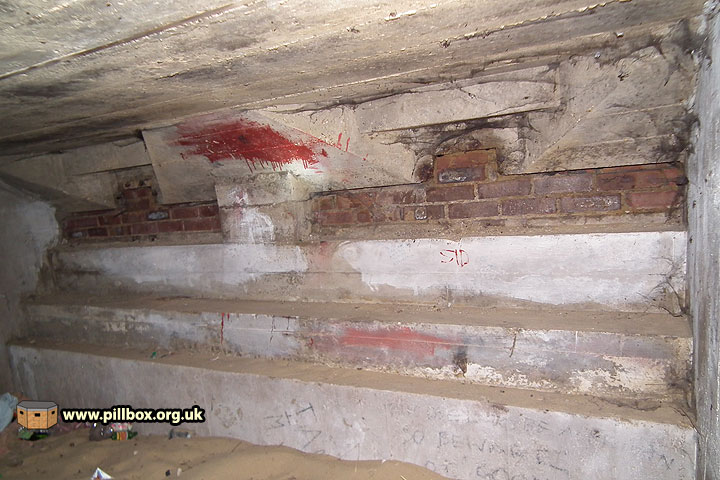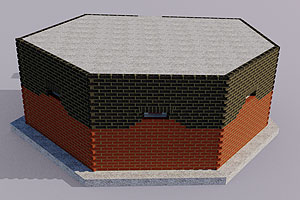Pillbox at Camber
Posted: 11 December 2011 12:06
I've been spending some time out at Rye and Camber looking at the defences there; one pillbox in particular has occupied a large proportion of my time. A 3D reconstruction was produced despite a key problem experienced during the survey process.
The 3D model was constructed in Google Sketchup and is the subject of the video (from my YouTube channel) at right.
If you cannot view the video, the graphics below will give you an idea of what it's all about.
The flythrough includes views around the outside and interior of the pillbox.
I've also created some very rough models of a Vickers gun and Bren gun on Turnbull mountings to give a better idea of how the pillbox design works.
Producing the video was the easy part, but constructing the model proved a lot harder and involved a lot of guesswork, as explained below.
The pillbox in question is situated amongst the sand dunes as shown below; you can immediately appreciate the slight problem I encountered when trying to study it in detail:

The pillbox is slowly sinking into the sand dune, its roof being at what is now ground level. The fact that the structure is "sinking" may be due in part to undermining of the foundations and a gradual build-up of sand of the past 70 years.
Judging by the graffiti and rubbish, plenty of people have been viewing the interior; the photo below is taken looking into the pillbox from the entrance. Note the stepping along both walls and the unusual geometry of the embrasures. The sand in here is about 50cm deep.

The view from inside looking back towards the entrance:

The photo below shows how each side wall has two embrasures, all bricked up. Again, note the complex geometry around the embrasure and the unusual vertical cut-out in the centre of the loophole.

So we've seen the interior, but how do we reconstruct the pillbox if we can only see the entrance porch protruding out of the sand? From the internal survey, we know that we have a rectangular structure. The full width could be measured extrenally, and subtracting the internal width, we have the thickness of the walls; 3 feet (1m), making this a shellproof pillbox.
The problem of how to reconstruct the exterior view was overcome by recognising that the embrasures were of an uncommon design similar to those of the pillbox at Horsebridge. Guided by the data from this pillbox, I was able to guestimate how the one at Camber would have looked and reconstructed it in Google Sketchup. The graphic below shows my impression of the pillbox when new in the background, with how it currently sits at a steep angle, embrasures bricked up. The foundation slab is speculative.

The embrasure is shown below - it was this complicated design that I was dreading trying to replicate in Sketchup, but it actually proved easier once I'd sat down and understood the geometry of it. It also lead to a better understanding of the design.
The square cut-out in the centre of the embrasure takes the Turnbull frame, while the upper stepping describes the arc of fire for the Turnbull - I hadn't realised this until I had actually built the model. Either side of the Turnbull is enough space for a rifleman to use the embrasure for close defence.

A lateral section cut through the pillbox shows the stepping of the interior walls. The arrangement of Turnbull mountings with a Bren gun (left) and a Vickers probably leaves insufficient space for their respective gunners to fight, so four embrasures allows the Turnbull weapons to be staggered.

A longitudinal section cuts through the exterior blast wall, entrance and crew compartment:

So we've perhaps answered a few questions about this pillbox - if anyone has any photos of it before it sank, I'd be interested to see them and adjust the model accordingly!
- Pete

Email:
Blog Latest

Bishopstone reveals its pillbox secrets
18 October 2021

Pillbox or Observation Post?
10 June 2020

Uncovering the hidden secrets of a pillbox
8 June 2019

Review of 2018
31 December 2018

Wartime Christmas in East Sussex (2)
24 December 2018
Jargon-buster
Embrasure
A loophole or slit that permits observation and/or weapons to be fired through a wall or similar solid construction.
Loophole
Embrasure
Pillbox
Generic term for a hardened field defensive structure usually constructed from concrete and/or masonry. Pillboxes were built in numerous types and variants depending on location and role.

Turnbull Mounting
A steel framework that allowed a machine gun to be mounted in an embrasure of a pillbox or other defence work. The mounting could be used with a variety of weapons, such as the Vickers Gun and Bren Gun. Traverse and elevation gear allowed the weapon to be fired on fixed lines.
This site is copyright © Peter Hibbs 2006 - 2024. All rights reserved.
Hibbs, Peter Pillbox at Camber (2024) Available at: http://pillbox.org.uk/blog/216692/ Accessed: 27 July 2024
The information on this website is intended solely to describe the ongoing research activity of The Defence of East Sussex Project; it is not comprehensive or properly presented. It is therefore NOT suitable as a basis for producing derivative works or surveys!